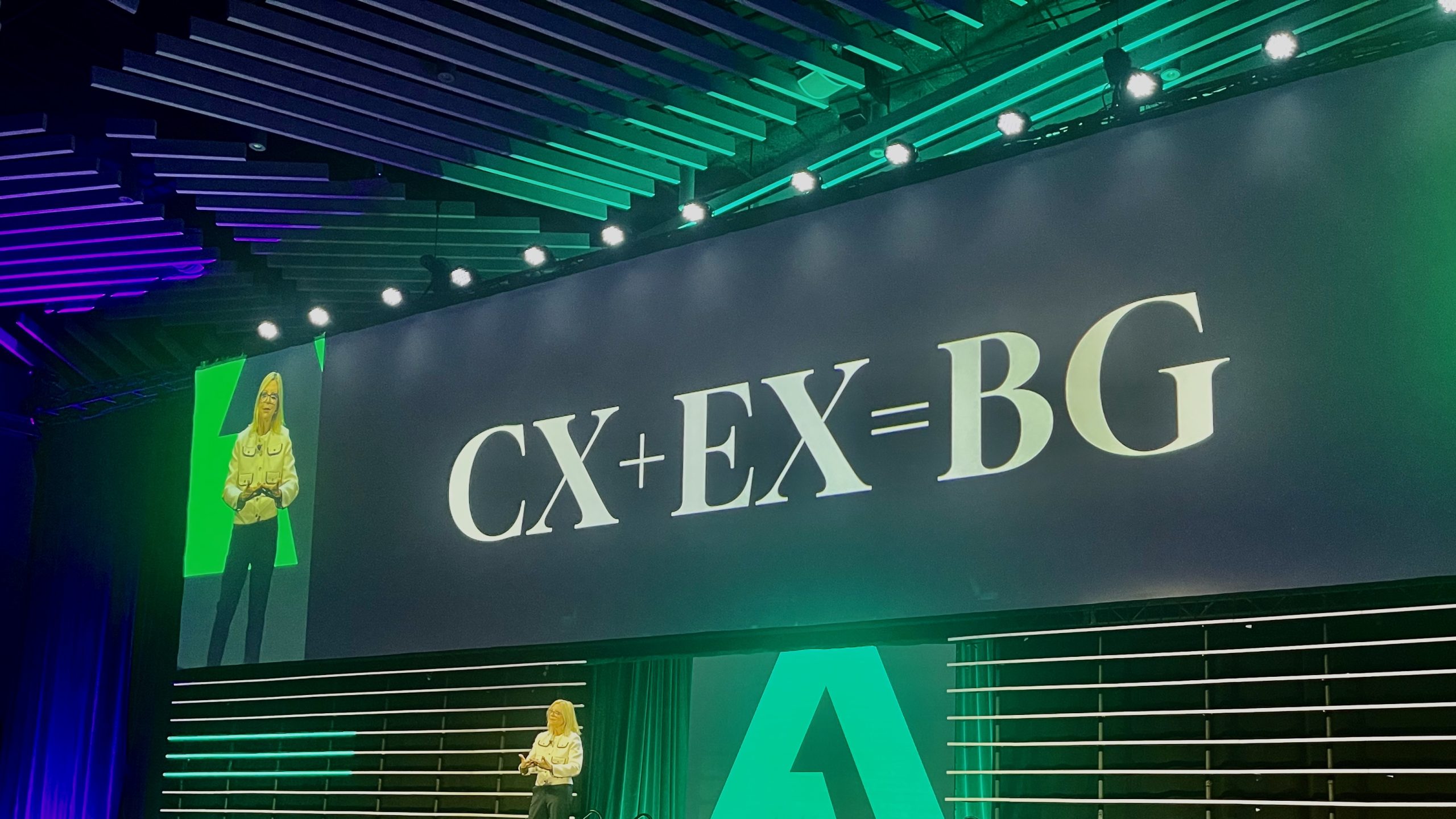
Avaya CRO and chief experience officer Marylou Maco discusses the company’s new “CX + EX = BG” philosophy at Avaya Engage 2024. Photo: Melody Brue
Avaya has undergone a remarkable turnaround in recent years, transitioning from financial turmoil to a position of strength and innovation. The company has successfully navigated bankruptcy, restructured its operations, and refocused its strategy under the leadership of CEO Alan Masarek and an essentially new C-suite. This transformation has increased profitability, strengthened the balance sheet, and renewed investor confidence.
At this year’s Avaya Engage, the company’s user, partner, and ecosystem conference, Avaya unveiled a significant change in its market approach. Specifically, it highlighted a combined focus on customer experience (CX) and employee experience (EX) as key drivers of future business growth (BG). This CX + EX = BG philosophy reflects a profound cultural shift within the company as it moves away from a utilitarian approach towards one that prioritizes holistic experiences.
During the event, CRO and chief experience officer Marylou Maco outlined the importance of both customer and employee experience in driving business growth. (It is not accidental that the company’s chief experience officer is also responsible for revenue.) As is typical of these events, Avaya highlighted several customers on stage, including Disney and Southwest Airlines, to showcase successful examples of prioritizing CX. Meanwhile, a new partnership with Arianna Huffington and her Thrive Global platform for well-being and behavior change emphasized the significance of EX within Avaya.
Avaya’s focus on the combined impact of CX and EX reflects the fundamental insight that happy employees lead to satisfied customers, resulting in improved business outcomes such as better agent satisfaction, increased loyalty, higher retention rates, and better overall performance . . . not to mention more revenue. Let’s take a look at the announcements from this year’s Engage conference and put them in context.
But First, AI
No conference these days is complete without an AI announcement or two, and Avaya’s was no exception. The company debuted several AI-powered enhancements for the Avaya Experience Platform (AXP), including a framework for integrating third-party digital assistants, a packaged solution for agent assistance using AI, and Avaya Ada, a generative AI virtual assistant to provide customer and partner support.
Avaya’s “open and integrated” approach to AI means it is developing its own AI technologies as well as partnering with other innovators in its field to offer customers a comprehensive suite of the most advanced solutions. Some of these solutions are discussed below.
Innovation Without Disruption
Avaya’s transformation aligns well with what Masarek has long touted as the company’s commitment to “Innovation without Disruption.” Recognizing that innovation should complement existing investments and deliver immediate value, Avaya emphasizes that customers should be able to adopt new technologies at their own pace. This customer-centric philosophy shows Avaya’s dedication to meeting the diverse needs of its clients—and that’s not just my opinion, because it also clearly resonated with many of the attendees I spoke with at the event.
Acquisition of Edify Technologies: A Potential Game-Changer for Customer Experience
During the conference, Avaya announced its acquisition of Edify Technologies—a move that further solidifies its commitment to customer experience. Edify’s low-code platform empowers businesses to create tailored customer journeys and offers out-of-the-box CRM connectors. This acquisition brings important capabilities to Avaya’s portfolio, including AI-powered enhanced workflow automation and customer journey orchestration. Once Edify’s platform is integrated with Avaya’s, that should streamline customer interactions and improve overall service efficiency for Avaya’s clients.
The Edify purchase also comes with a group of engineers who inject some “world-class customer experience talent” into the company, according to Masarek. This infusion reflects Avaya’s priority on aligning talent with company goals—something the company talked about in more detail at its Analyst Summit in April.
Avaya’s Expanded RingCentral Partnership
Avaya’s partnerships are a vital element of its strategy. At Engage, Avaya and RingCentral announced an expansion of their strategic partnership that will provide Avaya customers access to RingCentral’s advanced collaboration tools and AI capabilities while retaining Avaya Aura for telephony. This integration offers a modernized and comprehensive communication solution, further augmented by RingCentral’s direct routing and Microsoft Teams calling features.
Avaya’s expanded partnership with RingCentral also offers customers a more comprehensive and flexible approach to unified communications. By integrating RingCentral’s UCaaS suite Avaya customers can now leverage RingCentral’s messaging, video conferencing, and file sharing tools while maintaining the reliability and familiarity of their existing telephony systems. This hybrid approach caters to the diverse needs of enterprises, allowing them to adopt modern features while preserving their current investments.
Additionally, Avaya customers now have access to RingCentral’s RingSense AI platform, which includes features such as live transcription, closed captioning, video summaries, and video highlights.
Avaya and Zoom Workplace Collaboration
Zoom’s AI-powered collaboration suite, Zoom Workplace, will now integrate with Avaya’s call control solutions. This integration will enable Avaya customers to utilize Zoom Workplace as a UC client, complete with a new dialer configured for Avaya Aura systems. This strategic alliance marks a significant move for both companies, as it combines the strengths of each brand to offer a comprehensive solution for communication and collaboration.
Partnership Ecosystem and Integrations
Avaya showcased several integrations at Engage that further enhance the customer and employee experience around workforce management, intelligent routing, and improved digital channels.
For starters, Avaya has integrated Calabrio’s Workforce Management (WFM) solution with the AXP Public Cloud. This integration provides features such as predictive forecasting, omnichannel scheduling, and automated reporting, aiming to enhance efficiency and performance within contact centers.
Afiniti’s eXperienceAI, an AI optimization solution, is now also integrated into Avaya AXP, including the new AXP Private Cloud. This integration allows Avaya customers to easily add AI capabilities to their existing platform using a no-code tool. AXP now features native integration with eXperienceAI for intelligent routing based on extensive data points.
With the new LivePerson Conversational Cloud integration, AXP gains expanded digital channels, AI-powered conversational tools, and unified insights across various platforms. This integration is designed to improve customer and employee experiences while minimizing disruption and risk to existing operations.
My Analyst Take
As detailed above, Avaya is positioning itself to address the market’s evolving needs through strategic partnerships, acquisitions, and integrations. While the approach is sound, the company must also successfully integrate acquired technologies and ensure seamless collaboration with partners. The ever-evolving landscape of customer expectations and technological advancements also requires continuous innovation and adaptation—something Avaya was not known for in its pre-Masarek (and team) era. This is a challenge because not only does the company need to innovate, it also needs to convince the market that Avaya is a genuine and consistent innovative force. After some years of uninspiring performance under previous leadership, earning back the market’s trust is high on Avaya’s priority list, as CMO Josh Mueller emphasized during the company’s analyst summit.
By partnering with multiple UCaaS providers, including RingCentral, Zoom, and Microsoft Teams, Avaya demonstrates its commitment to customer choice and interoperability. This approach allows businesses to select the collaboration tools that best suit their needs while ensuring seamless integration with their Avaya systems.
Avaya’s commitment to the CX + EX = BG philosophy, its focus on innovation without disruption, and its strategic partnerships and acquisitions position the company well for future success. The road ahead may have some bumps, but Avaya seems determined to navigate it. I look forward to seeing where this new path leads as Avaya gives its customers complete control over how they modernize communications.























































































